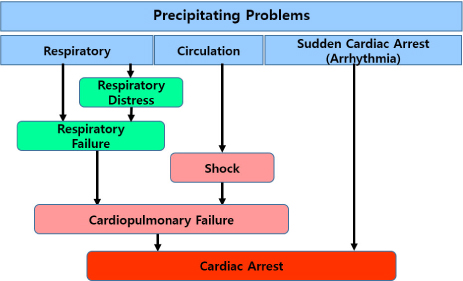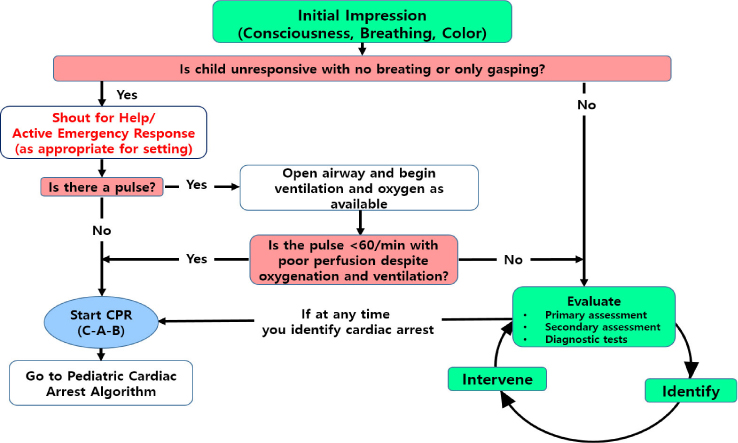J Dent Anesth Pain Med.
2016 Mar;16(1):9-15. 10.17245/jdapm.2016.16.1.9.
Pediatric advanced life support and sedation of pediatric dental patients
- Affiliations
-
- 1Department of Pediatrics, School of Dentistry, Dankook University, Cheonan, Korea. jbkim0222@dankook.ac.kr
- KMID: 2308760
- DOI: http://doi.org/10.17245/jdapm.2016.16.1.9
Abstract
- Programs provided by the Korea Association of Cardiopulmonary Resuscitation include Basic Life Support (BLS), Advanced Cardiac Life Support (ACLS), Pediatric Advanced Life Support (PALS), and Korean Advanced Life Support (KALS). However, programs pertinent to dental care are lacking. Since 2015, related organizations have been attempting to develop a Dental Advanced Life Support (DALS) program, which can meet the needs of the dental environment. Generally, for initial management of emergency situations, basic life support is most important. However, emergencies in young children mostly involve breathing. Therefore, physicians who treat pediatric dental patients should learn PALS. It is necessary for the physician to regularly renew training every two years to be able to immediately implement professional skills in emergency situations. In order to manage emergency situations in the pediatric dental clinic, respiratory support is most important. Therefore, mastering professional PALS, which includes respiratory care and core cases, particularly upper airway obstruction and respiratory depression caused by a respiratory control problem, would be highly desirable for a physician who treats pediatric dental patients. Regular training and renewal training every two years is absolutely necessary to be able to immediately implement professional skills in emergency situations.
Keyword
MeSH Terms
Figure
Reference
-
1. Wilson S, Farrell K, Griffen A, Coury D. Conscious sedation experiences in graduate pediatric dentistry programs. Pediatr Dent. 2001; 23:307–314.2. Kim S, Kim J. Introduction of sedation guidelines and need for sedationist. J Korean Acad Pediatr Dent. 2012; 39:314–324.
Article3. Kim J, Yoo S, Kim J. The qualification of dentist for sedation: BLS and ACLS. J Korean Acad Pediatr Dent. 2015; 42:80–86.4. Choi YS, Shim YS. Sedation Practices in Dental Office: A Survey of Members of the Korean Academy of Pediatric Dentistry. J Korean Acad Pediatr Dent. 1999; 26:579–588.5. An SY, Choi BJ, Kwak JY, Kang JW, Lee JH. A survey of sedation practices in the Korean pediatric dental office. J Korean Acad Pediatr Dent. 2005; 32:444–453.6. Bae CH, Kim H, Cho KA, Kim MS, Seo KS, Kim HJ. A Survey of Sedation Practices in Korean Dentistry. J Korean Dent Soc Anesthesiol. 2014; 14:29–39.7. Houpt M. Project USAP 2000-use of sedative agents by pediatric dentists: a 15-year follow-up survey. Pediatr Dent. 2002; 24:289–294.8. Coté CJ, Karl HW, Notterman DA, Weinberg JA, McCloskey C. Adverse sedation events in pediatrics: analysis of medications used for sedation. Pediatrics. 2000; 106:633–644.9. Yang Y, Shin T, Yoo S, Choi S, Kim J, Jeong T. Survey of sedation practices by pediatric dentists. J Korean Acad Pediatr Dent. 2014; 41:257–265.
Article10. Heo N, Lee K, An S, Song J, Shin G, Ra J. Aspiration and ingestion of foreign bodies in dental practice. J Korean Acad Pediatr Dent. 2015; 42:69–74.
Article11. D'Eramo EM. Mortality and morbidity with outpatient anesthesia: the Massachusetts experience. J Oral Maxillofac Surg. 1999; 57:531–536.12. Park YW. New Guideline of Pediatric Cardiopulmonary Resuscitation. Korean J Pediatr. 2004; 47:591–595.13. Cravero JP, Blike GT, Beach M, Gallagher SM, Hertzog JH, Havidich JE, et al. Incidence and nature of adverse events during pediatric sedation/anesthesia for procedures outside the operating room: report from the Pediatric Sedation Research Consortium. Pediatrics. 2006; 118:1087–1096.
Article14. Hwang SO. Cardiopulmonary resuscitation update. J Korean Med Assoc. 2013; 56:600–608.
Article15. Kim J. Application of a pediatric advanced life support in the situation of a dental treatment. J Korean Dent Assoc. 2015; 53:538–544.16. Chameides L. Pediatric Advanced Life Support: Provider Manual. American Heart Association;2011.17. ILCOR. International Liaison Committee on Resuscitation (ILCOR) 2015. Available from: http://www.ilcor.org/about-ilcor/about-ilcor/.





